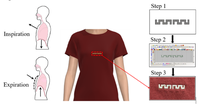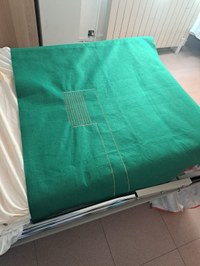Projects
TELEBREATH Telecare system based on intelligent fabrics for monitoring respiratory diseases in vulnerable groups (TED2021-131209B-I00)

The TELEBREATH project is oriented towards the challenge of contributing to a better attention to the demand for long-term care in
vulnerable groups such as the elderly and dependent people. The project focuses on the search for original scientific and technical
solutions based on the application of electronic textile sensors for the monitoring, monitoring and control of respiratory diseases (asthma, pneumonia, chronic obstructive pulmonary disease, pulmonary edema, etc.) or for early detection of diseases associated with alterations in breathing patterns (diabetes, heart failure, anxiety and emotional stress) in a minimally invasive way for users. To this end, new designs and strategies for the development of textile sensors and electronic systems fully integrated into standard clothing will be investigated, minimizing the impact on people's use with the aim of wearing a comfortable garment and allowing permanent control of the respiratory rhythm just by wearing a piece of clothing naturally. The main objective of the project is to investigate and develop a complete platform for telecare and monitoring of respiratory patterns using intelligent fabrics (e-textiles) that includes the sensor integrated completely in fabrics and the development of algorithms for the detection of respiratory anomalies, as well as the interface of data transmission to the cloud and its corresponding management through a software platform.
ETEXHEALTH Textile sensors for healthcare applications (PID2021-124288OB-I00)

ETEXHEALTH project is oriented towards the challenge of improving human health. The project focuses on searching original scientific and technical solutions based on applying electronic textile (e-textile) sensors to monitor human body biometric variables and disease evolution in a minimally invasive way. The main goal of the project is to develop innovative solutions for e-textile sensors operating at low and high frequency regimes with sensitivity and figure of merit beyond the state of the art. In particular, fully integrated fabric resistive and capacitive sensors will be assessed at frequencies below 1 MHz, whereas e-textile antenna-sensors and RFID-sensors will be studied operating at UHF, ISM and ultra-wide frequency bands. The main applications of these devices will be focused on corporal liquid leakage detection and control (urine, blood, sweat) and biomechanical variables sensing (temperature, pressure, fatigue, motion, moisture).
E-textiles involve the combination of electronics and fabric substrates to form "smart" textile products to allow flexible wearable solutions.The project will consider the full stage research and deployment of the e-textile sensors by considering their complete design, electromagnetic/performance simulation, manufacturing and characterization process. With regard to the fabrication, 3 main textile technologies will be considered: embroidery, inkjet printing and weaving. The impact of wearout textile mechanism on the sensors behavior will be analyzed to guarantee the practical functionality of the proposed structures on a final application. With the achievement of the proposed objectives in ETEXTHEALTH new products and application should be developed to take care of people's health at any age.
INELTEX New electronic design strategies for deployment of wireless sensor networks in smart textile (TEC2016-79465-R)

This project focuses on the integration of electronic components on textile substrates to facilitate the development of smart fabrics (smart textile) with regard to on-body wireless devices. The fundamental objectives of the project are the design, simulation and characterization of antennas, sensors and circuitry by means of materials and textile techniques. Narrow band, multi-band and ultra wide band (UWB) low profile antennas will be investigated. The main sensors considered will be capacitive, resistive and electrodes. The textile circuitry approach will be focused on the propagation signal analysis on e-textiles at low and high frequencies as well as the electromagnetic compatiblity performace. For each of these components it will be required to analyze the impact of different integration textile techniques such as fabric ligament, conductive pastes and printing technologies, dressmaking and embroidery, in order to achieve a high degree of comfort, strength against washing, flexion fatigue, etc.
To reach the proposed objectives our multidisciplinary research team is composed by members of the departments of Electrical Engineering, Textile Engineering and Chemical Engineering at the Universidad Politécnica de Cataluña. In order to demonstrate the viability of our proposal, a e-health prototype based on both antennas and sensors will be developed and tested with the aim to validate the effectiveness degree of the proposed implementations coming from the projects research outputs. This project can be linked with the national and international collaborations of the applicants as well as the Estrategia Española de Ciencia y Tecnología y de Innovación and particularly in the Reto Economía y Sociedad Digital with regard to the TIC applications and solutions. Its applicability is also closely linked with the Reto Salud, Cambio Demográfico y Bienestar.
DERSITI New electronic design strategies for deployment of wireless sensor netwotks in smart textile (TEC2013-41996-R)

The fundamental objective of this project consists of the study of new techniques and methodologies for designing low-cost integrable wireless sensor networks on smart textile applications. During the execution of the project there will be defined new strategies of electronic design in order to optimize parameters such as the consumption, the size, and the circuit topology. This fact will definitely allow to reduce the cost of implementation of these motes and, as a consequence, to facilitate the massive deployment of wireless sensor networks integrated on fabric. In order to achieve the main objective and due to the nature of the sensor motes including different kinds of electronic circuits (analog electronics, digital electronics and radiofrequency electronics) it will be necessary to analyze their electromagnetic compatibility (EMC) issues and to propose design techniques to enhance their immunity against interference, both internal and external. In fact, the design of new topology circuits and layout will be addressed, including the use of conventional and advanced materials (metamaterials). In addition, the aging impact of the proposed motes will be analyzed in order to predict their reliability performance, as well as their behaviour under extreme conditions. From the textile point of view, new dressmaking and embroidery techniques will be investigated to provide the integration of the electronic systems on the fabric in order to achieve a high degree of comfort, strength against washing, flexion fatigue, etc. In this way, by taking into account the required specifications of the motes, several conductive textile samples based on stitch, pattern or CAD embroidery will be manufactured and analyzed according to the ISO and UNE standards. In order to demonstrate the viability of our proposal, several prototypes will be developed and tested with the aim to validate the effectiveness degree of the proposed implementations coming from the project’s research outputs. Finally, after developing low-cost motes, a low-cost wireless sensor network will be set up for an e-health application. The proposed project can be linked with the national and international collaborations of the applicants as well as the Estrategia Española de Ciencia y Tecnología y de Innovación, and in particular, the Reto Economía y Sociedad digital with regard to TIC solutions.
.




Share: